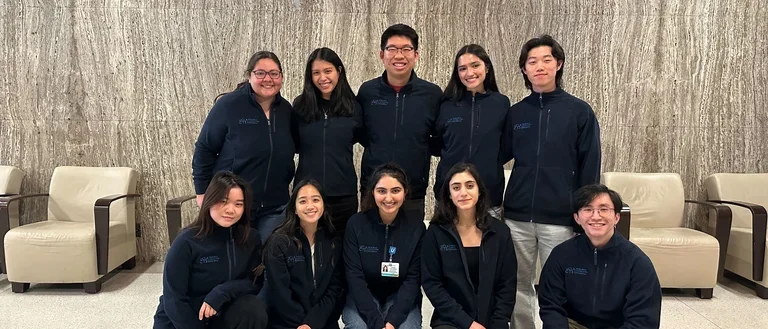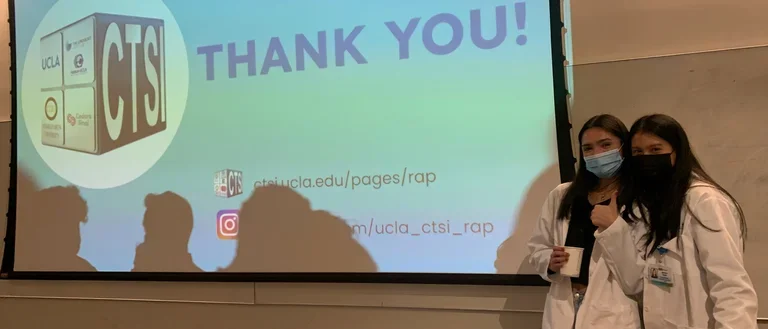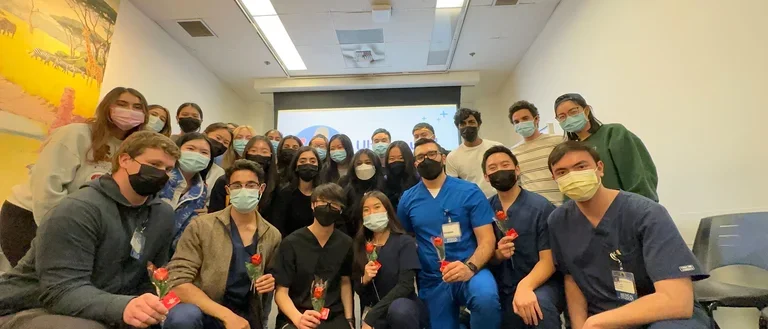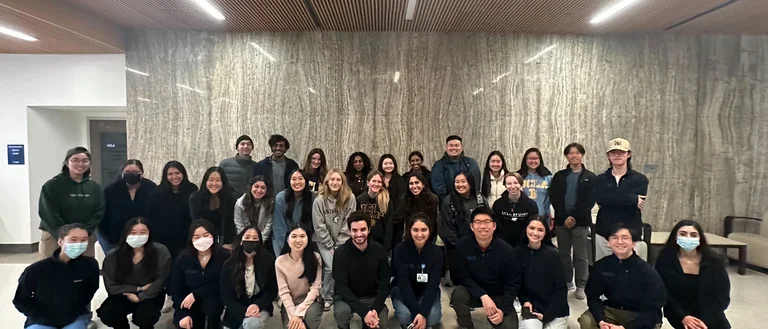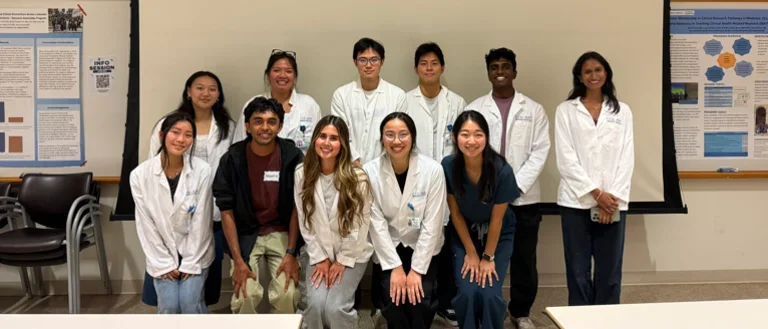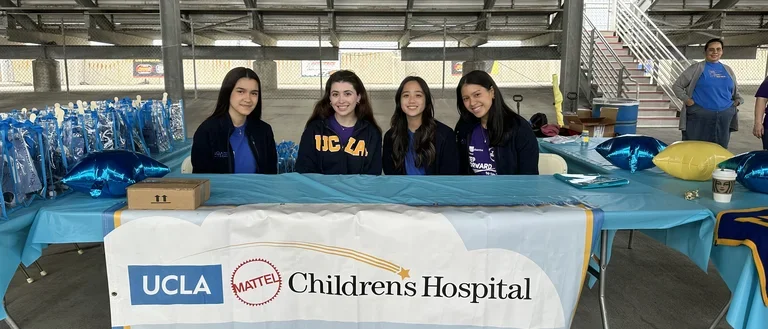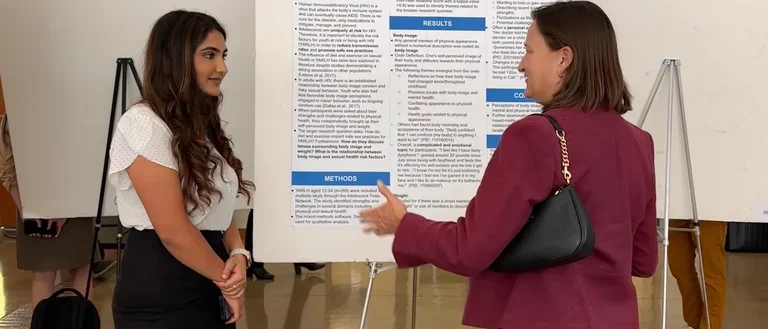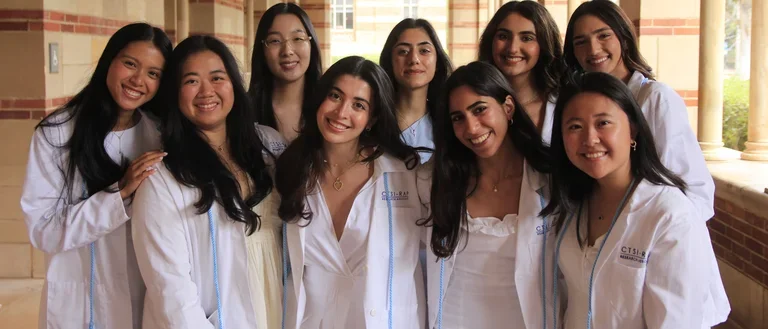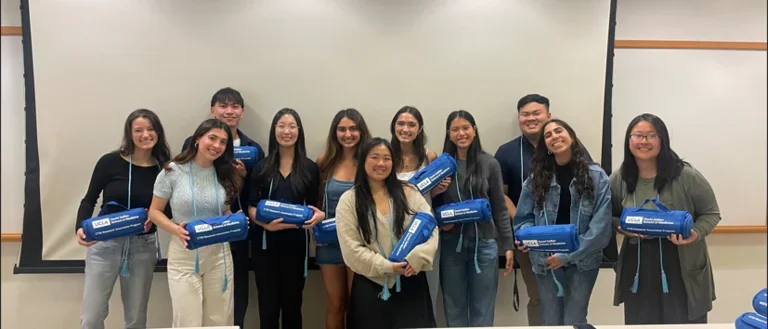Research Associates Program (CTSI-RAP)
Gain exposure to hospital-based medicine and clinical research
Apply to CTSI RAP
ApplyAlert
Play a vital role in research initiatives at UCLA
The UCLA CTSI Research Associates Program (CTSI-RAP) provides undergraduate UCLA students with the opportunity to gain exposure to hospital-based medicine as well as clinical research in an academic medical center.
The program builds a stronger support infrastructure for the research initiatives of UCLA faculty physicians and investigators. Research associates play a key role in the implementation and integrity of research protocols in which they are involved. RAP students are also given the opportunity to make rounds with medical teams, observe common procedures, and experience didactic teaching sessions during the course of their research days. The unique blend of first-hand clinical experience and scientific research gives alumni a unique advantage in public healthcare.
RAP activities
Research associates are trained to conduct clinical research studies, collect and maintain securitized data, assist in the authorship of research protocols, aid in statistical analyses, and co-author abstracts, posters, and papers. In addition to research, students are exposed to experiences meant to educate and prepare them for a career in healthcare. As a result, research associates become comfortable with the workings of a hospital and gain skills in professionalism, patient communication, and research methodology.
Program Benefits:
- Clinical Research Experience
- Hospital Volunteer Hours
- Rounding with Attendings
- Observing Procedures
- Opportunity to mentor high school students through partner program UCLA MATCH
- Strong alumni network 160+
News Articles and Social Media:
- A decade of research excellence: Alumni spotlight (2023)
- UCLA MATCH inspires high school students across LA (2023)
- CTSI-RAP alumni careers take flight (2021)
- Eight Years Strong: CTSI-RAP Develops Next Gen Clinical Researchers, Undergraduate Research Week and Beyond (2021)
- CTSI-RAP Undergraduate Research Day 2020 Article (2020)
- Need Support on your study? CTSI-RAP students are ready to assist (2019)
- UCLA DGSOM 2019 Dean’s Report Feature (p. 40) (2019)
- CTSI RAP Program Marks Its First Five Years (2018)
- View and like our CTSI-RAP Facebook page!
- Follow our CTSI-RAP Instagram Page!
Ophthalmology - Limbal Stem Cell Studies [IRB 19-001056, 10-001601, 21-000609]
PI: Sophie Deng
Study Liaison: pending
Description: A. This is a single center phase I controlled, randomized, open-label clinical study. 20 patients with severe to total Limbal Stem Cell Deficiency (LSCD) in one eye attributable to injury or ocular surgery will be enrolled. The first 5 enrolled eyes will receive the cultivated autologous limbal stem cells (cLSC) to determine the feasibility and safety. Then the subsequent 15 enrolled eyes will be randomized into cLSC group and a scleral lens treatment (SCL) control group in a 2:1 ratio in blocks of 3 or 6 using a random number generator. All subjects will be followed for 12 months after treatment. There will be 13 visits over a span of 360 days. Cell therapy using cultivated autologous LSCs has been developed as a potentially better alternative to various direct transplantation methods of limbal tissues; it greatly lowers the risk of damage to the donor eye by decreasing the amount of tissues that need to be harvested from the donor.
B. This study aims to find out a diagnosis system of LSCD at the cellular level using the information obtained from a special high resolution microscopy and Impression cytology. A well-established in vivo confocal microscopy, with the HRT III Rostock Cornea Module, has the capability to enable clinicians to take photos of the corneal and limbal structures at single cell level in patients. Confocal microscopy has been routinely used as a diagnostic tool to determine the corneal endothelial cell count in patients. This clinical test has also already been used to evaluate and document the structures of the ocular surface in patients with abnormal corneas. We plan to analyze these photos only from patients with LSCD and patients with normal ocular surface. According to the presence of the conjunctival cells in the cornea, we could diagnose LSCD in an earlier stage. Analyzing the percentage of conjunctival phenotype cells in the cornea and limbus, and the changes in the structure in the limbus, the functional status of LSCs could be determined and LSCD can be classified to different stages. Impression cytology is a routine clinical test that allows for collection of the most superficial layers of the cells using a sterile filter paper. It is a well-accepted noninvasive, rapid and fairly painless diagnostic tool for common ocular surface diseases and for monitoring the disease progression. Slit Lamp Photography and Optical Coherence Tomography (OCT) will also be performed. The measurement of corneal sensation will be performed to determine corneal nerve function of patients with LSCD and patients with normal ocular surface before performing confocal microscopy. The last test is impression cytology on the cornea and conjunctiva.
C. This research study aims to collect tears from patients suffering from limbal stem cell deficiency to identify specific molecular markers of the disease that couldbe explored as future therapeutic targets. Control groups will include tear collection from normal eyes and dry eyes. The tears will be collected as a one-time event.The tears biomarkers will also be correlated with corneal sensation and in vivo epithelial function using anterior segment optical coherence tomography (AS-OCT),in vivo confocal microscopy (IVCM), and impression cytology (IC).
RAP Responsibilities: - Data collection and management:
• Abstract relevant information from medical records of research participants and input it into spreadsheets to be reviewed by senior study staff
• Transfer and organization of imaging data (In-vivo confocal microscopy and AS-OCT scans)
· Research activities:
• Guide participants to treatment/evaluation/imaging area
• Verify specimen collection and delivery to lab
• Observation of clinic, imaging, and treatment procedures
• Assist research coordinator with study visits per protocol
•Opportunities are available to formulate and answer research questions with appropriate mentorship
Pediatric Neurology Studies (4) 1: Autoimmune Endocrinopathies 2: LP352 in Seizures for Developmental and Epileptic Encephalopathies 3: LP352 in Seizures for Dravet Syndrome 4: Tuberous Sclerosis Complex [IRB: 24-1072, 24-5913, 24-6296, 15-0205]
PI: Rajsekar Rajaraman
Study Liaison: pending
Description: pending
RAP Responsibilities: pending
Attributes of Trustworthy Care and Institutional Barriers [IRB: 24-5241]
PI: Frederick Ferguson
Study Liaison: Desiree Rojo
Description: pending
RAP Responsibilities: The primary responsibilities will include coding qualitative data, contributing to thematic analysis, and participating in consensus and confirmation processes to ensure analytical rigor. The role requires a strong understanding of qualitative research methods and excellent communication skills to collaborate effectively with the research team.
KEY RESPONSIBILITIES:
• Conduct initial and secondary coding of qualitative data.
• Collaborate with the research team to identify and refine themes.
• Participate in consensus meetings to confirm coding reliability and thematic accuracy.
• Document analysis decisions and ensure consistency in coding.
• Assist with organizing and preparing analysis materials.
Rheumatology - Lupus Studies (2) 1: Hydroxychloroquine for Systemic Lupus Erythematosus 2: Belimumab for Early Lupus [IRB: 20-002231, 19-002181]
PI: Maureen McMahon
Study Liaison: Kavya Kumar
Description: Belimumab (also known as BENLYSTA™), given into a vein by intravenous (IV) infusion, has been approved in the United States, Canada, Europe and Japan for the treatment of adults with active SLE who are receiving other lupus medicines. However, the effects of belimumab when it is given to patients with early lupus (within 2 years of diagnosis) who have not received lupus medications other than hydroxychloroquine(Plaquenil) are not known. Belimumab has additionally been approved in the United States to be given as a subcutaneous injection which is an injection under the skin. In this study, belimumab will be given as a subcutaneous injection (under the skin).
This is randomized double-blind placebo-controlled trial of belimumab in 30 subjects with early lupus with mild to moderate clinical symptoms and evidence of autoreactivity. Subjects will be randomized in a double-blind, placebo-controlled fashion in a 2:1 ratio to receive treatment with subcutaneous belimumab 200 mg weekly and stratification of study arms after one year of treatment.
Study objectives are as follows:
Primary objective: To evaluate the immunologic effects of belimumab in early SLE
Secondary objectives: 1)To evaluate the clinical effects of belimumab in early SLE (2) To evaluate safety and tolerability of belimumab in early SLE (3) To evaluate the immunologic effects of belimumab withdrawal in early SLE (4) To evaluate effects of belimumab on cardiovascular risk in early SLE
RAP Responsibilities: CTSI-RAP students function as clinical coordinator assistants within the research study. Students conduct patient screening to determine study eligibility for prospective participants, audit and maintain patient files, optimize and conduct study participant recruitment strategies, and observe consenting process and guidance of subjects through experimental procedures. Students also assist with blood sample handling and processing. Students will escort patients to study appointments within the UCLA-Westwood campus and conduct phone calls to study participants to ensure their return for follow-up testing. CTSI-RAP students will become familiar with UCLA electronic medical record system by accessing patient charts for data collection and analysis.
Integrated Network for Breakthrough Discoveries for Thriving With Bipolar Disorder (BD^2) [IRB 23-5190]
PI: Jennifer Kruse
Study Liaison: Alexander Lee
Description: The purpose of the Integrated Network (BD2 Study) is to improve the health and well-being of people living with bipolar disorder by engaging a network of collaborating investigators and clinicians to implement and inform data-driven improvements in care, build an unprecedented data ecosystem for bipolar disorder comprised of longitudinal clinical and biological data, generate novel insights for interventional approaches.
Following phone screening to determine potential eligibility, participants will undergo two in-person sessions. Following informed consent, the first session will consist of a blood draw, questionnaires, cognitive testing and a 60-minute MRI scan. At the end of the first session, participants will be asked to complete remote interim assessments consisting of diaries, questionnaires, and use of a wearable data collection device. The second session will occur approximately 12 months later, and will once again consist of a blood draw, questionnaires, cognitive testing and a 60-minute MRI scan.
RAP Responsibilities: 1) Conducting phone screening of potential subjects
2) Preparing recruitment materials, such as recruitment outreach letters
3) Scheduling participants for in-person clinical visits
4) Administration of structured interview and assessment materials
5) Preparation and download of wearable data collection devices
6) Assisting as a Second Safety for MRI scans
7) Assisting project coordinator with remote and in-person patient evaluations (ie: cognitive assessments)
8) Data entry and cleaning
9) Accompanying participants from one campus location to another
10) Transporting blood specimens from one campus location to another
Machine Learning Analysis of Retinal Imaging and Clinical Data to Predict Outcomes [IRB:25-0901-AM-002]
PI: Adrian Au
Study Liaison: Miah Chao (temporary)
Description: This research study aims to better understand how eye scans and clinical information can be used to predict how the retina is functioning and how it may change over time in people with retinal disease. We will look at medical records and images that were already collected from patients during their regular eye care visits. These include eye scans like optical coherence tomography (OCT), photographs of the retina, results from vision tests and other information like age, diagnosis, and, if available, genetic results.
We will use computer-based tools-specifically, a type of artificial intelligence called machine learning-to find patterns in the data. These patterns may help predict how a person’s retina will change structurally (like fluid or scarring in the eye) and functionally (like changes in vision or test results). The data will be carefully coded so that no personal information is used during the analysis. Our goal is to improve how we forecast disease progression and personalize treatment for future patients with retinal conditions.
RAP Responsibilities: 1) Extract and organize multimodal ophthalmic data. 2) Perform data cleaning and preprocessing for machine learning analysis. 3) Conduct literature reviews to support hypothesis generation and interpretation of findings. 4) Participate in weekly case conferences or journal clubs focused on retinal disease and AI applications. 5) Analyze associations between clinical variables, imaging features, and genetic data (if available).
(1) Effects of Obesity treatments (2) Weight Trajectories of Children with Parental Obesity [IRB: 24-6058, 24-1080]
PI: Vibha Singhal
Study Liaison: Shreya Sundar
Description: The purpose of this study is to develop a smartphone app aimed at reducing over-eating behaviors among adolescents with obesity based on the theory that addictive behaviors are driven by a displacement mechanism in the brain. Based on displacement theory, over-eating and associated weight gain are the result of situations that individuals feel they cannot successfully face nor avoid.
We will beta test the app with one group of youth living with obesity and make changes based on their feedback. Then we will evaluate the feasibility of the app among 30 adolescents to identify barriers and facilitators to its use. The impact of app engagement and usage on clinical outcome measures (weight and BMI, diet and snacking, and addictive behaviors related to food and substance use) and potential mediators/moderators (motivation for change, perceived stress, and distress tolerance) will be assessed preliminarily.
RAP Responsibilities: Participation in the screening and recruitment process, which would include looking through clinic schedules via Care Connect to identify potentially eligible patients, returning calls for interested participants using a screening script, and scheduling visits.
Assist with data collection by maintaining REDCap data and organization within the Box drive and regulatory binder.
Alzheimer's Disease and Dementia Studies (3) 1: Alzheimer's Disease Neuroimaging Initiative 2: ACTC Brain Donation Program 3: Biomarker Evaluation in Young Onset Dementia from Diverse Populations [IRB: 16-002070, 23-5054, 23-5157]
PI: Maryam Beigi
Study Liaison: Jake Ampong
Description: 1. ADNI4. Longitudinal observational study. Population: Cognitively unimpaired, and those with mild cognitive impairment or mild dementia d/t AD. Biomarkers, cognitive testing, and history will collected with cognitive testing annually or every other year. Objective: Build a biorepository with underrepresented pop.
2. ACTC BDP. Patients from eligible studies (A4, LEARN) may enroll in brain donation. Sites will contact pt q6 months to touch base, do brief history, complete questionaires & cognitive testing. Objective: Increase brain donation as it is the gold standard for diagnosis and to better understand AD and ADRD.
3. BEYONDD: Longitudinal observational study. Population: Early onset dementia (EOD). Interested participants will come to clinic from a remote cohort for history, physical, cognitive testing, and MRI. Objective: To better understand EOD and build a biorepository.
RAP Responsibilities: Assist research coordinator (CRC) with study visits per protocol, data entry and analysis, recruitment & retention, and coordinate participant activities. Escort patients to ancillary dept (MRI, PET, clinic, etc.) for research study visits. Can perform cognitive evaluations, obtain vitals and EKG, and processing research samples once training is completed. Assist at community events to raise awareness about Alzheimer’s disease and importance of participating in clinical research studies. Assist with other supportive activities administrative assistance if time allows. Can participate in creating abstracts, posters, papers, presentations
Neural Biomarker Profiling in Cardiomyopathy Patients Referred for Electrophysiology Study [pending]
PI: Olujimi Ajijola
Study Liaison: Nikash Gounder
Description: Arrhythmias have been shown to be tightly linked to the function of the cardiac nervous system in healthy and in diseased hearts. Cardiac injury (myocardial infarction, heart failure) causes alteration of the cardiac nervous system. The goal of this study is to examine neuropeptides (proteins released by or acting on the nervous system of the heart) and their ability to predict cardiac dysfunction, arrhythmias and sudden cardiac death. We will collect 4-6 cc of blood during the patients routine electrophysiology study and/or cardiac ablation procedure. The blood will be sent to our research lab for processing. The goal is to collect 150 blood samples to examine these biomarkers.
RAP Responsibilities: Learn about cardiac conditions and neural biomarkers involved in this study.
Learn about the clinical research process.
Participate in the consenting process (prepare consent packets and make copies for the patient after consent)
Bring the blood tube to the cath lab.
Attend the ablation procedure (1 hour maximum) in order to collect the blood tube from the physician.
Walk the blood tube to the CHS lab technician after it is collected.
Participate in research conferences/journal club, if interested.
Prepare a posters or summary of the project for the student and/or department research meeting.
Pediatric Neonatology - Nutrition and Infant Development (Study 1): Metabolic mechanisms induced by enteral DHA and ARA supplementation in preterm infants [IRB 22-001345] (Study 2): Closing the gaps in neonatal nutrition through data science [IRB 21-000379].
PI: Kara Calkins
Study Liaison: James Lee
Description: (Study 1) This study involves the use of a nutritional supplement called DHA & ARA. DHA and ARA are fatty acids. The researchers hope to learn if providing this supplement to premature infants will be beneficial to them, and what dose and regimen works best. The study will enroll infants born prematurely between 25 and 30 weeks of gestation. Participants will be randomized to one of four groups. Group 1 will receive the nutritional supplement throughout the duration of the study. Group 2 will receive no nutritional supplements. Group 3 will receive supplements from enrollment through 31 6/7 post-menstrual age (PMA), then no supplement from 32 to 36 weeks PMA. Group 4 will not receive supplements from enrollment through 31 6/7 PMA, but will receive them from 32 to 36 weeks PMA. Participation involves 8 visits with the research staff. During these visits, participants will have body measurements performed, and samples collected (milk, blood, urine, stool, and saliva samples). Information from the medical record will be collected throughout the study. The intervention will last through 36 weeks PMA or at discharge from the hospital.
(Study 2) Studies examining the impact of nutrition on short and long-term outcomes in infants in the neonatal intensive care unit (NICU) are often limited to single centers and by small numbers. As a result, we cannot evaluate practices in nutritional delivery for specific groups of infants. To address these gaps, we aim to establish a NICU Nutrition Collaborative (NNC) where longitudinal data across multiple centers can accrue data large enough to answer questions across a range of birth weights and gestational ages. We will then approach these questions using evolving data analytical approaches such as advanced population statistics and machine learning.
RAP Responsibilities:
- Collecting detailed nutritional and demographic data along with data about the subject's hospital course from the EMR
- Entering, organizing, and verifying data into a secure database (REDCap) used across our collaborators: UT Health and Cornell
- Attend lab meetings for UCLA and collaborators
- Prepare specimen collection kits and labels for subjects' specimen collections
- Assist with data analysis
- Assist with specimen collections and measurements
- Opportunities are available to formulate and answer research questions with appropriate mentorship; data can be presented in abstracts and manuscripts
Ophthalmology Studies (2): (Study 1)Imaging of intraocular inflammation [IRB 19-001732]; (Study 2) Study of ocular disease using hyper parallel OCT [IRB 20-000286]
PI: Edmund Tsui
Study Liaison: Amber Henny
Description: (Study 1)Uveitis (inflammation inside the eye) is one of the leading causes of blindness and is associated with significant complications such as vision loss, band keratopathy, and uveitic glaucoma. Therefore, the evaluation and detection of inflammation is critical in management of uveitis. Utilizing state of the art ophthalmic imaging technology will provide objective, reproducible measures of intraocular inflammation that can be quantified and monitored longitudinally. The proposed study will enroll all consecutive patients with either non-infectious or infectious uveitis in the Uveitis Service at the Stein Eye Institute. Each participant will undergo their routine clinical examination at the Stein Eye Institute, which will include a full clinical examination and photos to be taken of the eye using cameras, such as anterior segment optical coherence tomography, laser flare photometry and other ancillary testing which would be performed routinely as part of their clinical care.
(Study 2) A novel imaging technology termed Hyper Parallel OCT (HP-OCT) will be used to evaluate patients with cataracts, corneal disease, macular disease, optic nerve disease, iris changes that may occur from associated ocular diseases and procedures and uveitic diseases. Imaging obtained with theHP-OCT will be compared to routine standard of care imaging.
RAP Responsibilities:
- Collection of clinical research information
- Observation of procedures
- Transfer of imaging data
- Assisting with creation of REDCap database
Behavioral Weight Loss Intervention Utilizing Mobile Health Technology [IRB: 19-001992]
PI: Theodore Moore
Study Liaison: Bella Moore
Description: This is a pilot study enrolling obese patients, age 10-30, in an addiction model based smartphone mobile health (mHealth) weight loss intervention with coaching at a minimum of 100 days after hematopoietic stem cell transplantation. Patients will be screened and enrolled by the study coordinator, who will collect/submit biospecimens in addition to patient demographic characteristics and clinical outcomes. At the initial visit and enrollment, equipment will be disbursed to patients along with a schedule that outlines the 4-month intervention plan. After the initial visit, participants will participate in two additional teleconference visits at 2 months and at the conclusion of the study at 4 months. Participants will also be involved in weekly phone calls and daily weekday texts to discuss their status for the 4 month duration. This study will then correlate the results in change of BMI with patient characteristics, adherence to intervention, changes in metabolic parameters, physical activity levels, and addictive eating behaviors. We are aiming to recruit a total of 20 adolescents/young adults total. No pilot group is necessary since the feasibility of this intervention has been validated in prior published studies.
RAP Responsibilities: CTSI-RAP students function as clinical coordinator assistants within the research study. Students conduct patient screening to determine study eligibility for prospective participants, audit and maintain patient files, optimize and conduct study participant recruitment strategies, and observe consenting process and guidance of subjects through experimental procedures. Students also assist with blood sample handling and distribution of patient questionnaires. Students will escort patients to study appointments within the UCLA-Westwood campus and conduct phone calls to study participants to ensure their return for follow-up testing. CTSI-RAP students will become familiar with UCLA electronic medical record system by accessing patient charts for data collection and analysis.
Experimental Models of Depression and Aging: anxiety, inflammation, and reward mechanisms [IRB 21-001246]
PI: Chloe Boyle
Study Liaison: Erin Lee
Description: The purpose of this study is to use an experimental inflammatory challenge to examine whether older adults with symptoms of anxiety experience loss of pleasure or loss of motivation when they are exposed to inflammation. Loss of pleasure or loss of motivation will be evaluated using self-report questionnaires, computer tasks, and during a brain scan. Participants will undergo phone screening, two in-person visits, and telephone follow-up. The first visit will last 4 hours and the second visit will last 10.5 hours. Phone Screening and Visit #1: following phone screening to determine potential eligibility, participants will have an in-person evaluation. Following informed consent in the first session, participants will undergo semi-structured clinical interviews and complete questionnaires to assess medical- and medication histories; current- and past history of psychiatric disorders, and evaluation of behavioral symptoms of anxiety and depression. They will also complete behavioral reward tasks. Visit #2 and telephone follow-up the second session begins at 7:30AM and involves placement of two intravenous catheters, evaluation of heart rate and blood pressure, administration of endotoxin vs. placebo, repeated blood sampling, computer tasks, and self-report questionnaires for 10.5 hours. Two hours post-injection participants will complete a 1-hour brain scan. Study staff will escort the participant to a nearby facility to complete the brain scan. 24 hrs and 2-weeks following this session, staff will call the subject and ask about physical and mood symptoms.
RAP Responsibilities:
- Assist with patient screening (via standardized phone script) and recruitment (sending out letters) at the Cousins Center Call Center
- Administer behavioral tests and questionnaires during experimental appointments and complete mood assessments via phone.
- Assist in fMRI scans as a “safety second” - this will be under the direct supervision of the study PI. This will require the student to be available from 11:40AM-12:50PM on weekdays to attend the scan (the specific day will depend on the scheduling availability at the CTRC). The student will have the opportunity to learn how to conduct fMRI safety screening, set up a participant for a scan, and collect data. The student may also assist in patient transport from the CTRC to CCN for the fMRI scan (and vice versa).
- Participate in bi-weekly journal club/lab meetings; focus will be on study review, preparing abstracts/posters/papers (depending on the level of interest in the student); conducting literature searches (related to anxiety, inflammation, aging, and reward).Data analysis and preparation
Alzheimer’s-related inflammation and immunoregulatory deficiency [IRB 18-000434]
PI: Molly Fox
Study Liaison: Ashton Hawkins
Description: STUDY AIMS: This study investigates how various experiences across her lifespan shape how immune system functions during the geriatric phase of life, and specifically how this affects the inflammatory aspects of Alzheimer's Disease risk. We will focus our assessments on women's reproductive life-history, infectious disease history, medical history of autoimmunity, and dental health history -- and explore how these together affect inflammatory processes in geriatric life. Immunological dysfunction is an early feature of Alzheimer's Disease progression, so understanding how lifespan predictors affect immune function can help us discern the biomechanism by which certain lifespan risk factors affect the development of Alzheimer's Disease.
METHODOLOGY: Target cohort: This is a cross-sectional case/control study of 40 geriatric women (30 with/ 10 without AD), assessing reproductive history, AD status and age-at-onset, olfactory function and immunoregulatory cell concentration in peripheral blood. Participants are recruited from the Pacific Brain Health Center in Santa Monica and Olive-View UCLA Medical Center.
Session activities: Interviews with proband and informant, odor identification test, phlebotomy.
RAP Responsibilities: Student will abstract relevant information from medical* and dental records of research participants, and input this into our database. This activity will be performed in Dr. Fox’s lab on desktop computers provided. Interested student may also participate in the processing of biological specimens (swabs, blood, saliva) collected from research participants and dropped off at PI’s lab, or conducting phone/zoom consent and interviews with participants and informants.
Pediatric Immunology and Allergies [IRB 19-001413, 20-000897] (Study 1) Using Biologics to Improve Multi OIT Outcomes; (Study 2) Long-term Clinical Benefit and Safety of Peanut Patches in Peanut-Allergic Children
PI: Maria Garcia-Lloret
Study Liaison: Isabelle Shum
Description: EPOPEX: This is an open-label, follow-up study for subjects who completed the EPITOPE study. The objectives of this follow-up study are to assess the clinical benefit of Viaskin Peanut after up to 3 years of epicutaneous immunotherapy (EPIT) to induce/maintain desensitization to peanut in peanut-allergic children and to evaluate the safety of long-term treatment with Viaskin Peanut. Repeated daily application of Viaskin Peanut dosed at 250 ìg peanut protein per patch is planned for 2 years or 3 years. Food challenges will be conducted after 1, 2 and 3 years of EPIT treatment with Viaskin Peanut.
COMBINE: This is a prospective Phase 2, multi-allergen oral immunotherapy (OIT) study in participants with proven allergies to 2 or 3 different foods in which one must be peanut. Our intent is to treat a population of 110 participants, ages 5 to 55 years, with combinations of placebo, omalizumab, and dupilumab. All cohorts will receive multi-food allergen oral immunotherapy. At week 32, participants will discontinue treatment and will undergo food challenges. Participants who tolerate food challenges will stop active OIT dosing and undergo food challenges at week 44. Participants who tolerate food challenges at week 44 will be considered as achieving sustained unresponsiveness.
VITESSE: This is a 12-month, Phase 3, double-blind, placebo-controlled, randomized study to assess the efficacy and safety of daily DBV712 250 ìg in peanut-allergic children aged 4-7 years. The study duration is approximately 58 weeks: 4-week Screening Period, 12-month Treatment Period and 2-week Follow-up Period. 600 subjects will be enrolled in a 2:1 ratio (400 subjects in the DBV712 250 ìg group and 200 subjects in the placebo group). Subjects will apply either DBV712 250 ìg or placebo daily for a period of 12 months. At Month 12, a post-treatment food challenge will be performed.
ADORED: This is a Phase 1b/2, randomized, double-blind, multi-center study to evaluate the safety, tolerability, and preliminary clinical efficacy of STMC-103H in neonates and infants at risk for developing allergic disease (Type 1 hypersensitivity). Participants in the safety-run portion of the study will receive 28 days of treatment with STMC-103H or placebo, followed by 28 days of follow-up. Afterwards, we will enroll 224 patients for 336 days of treatment with STMC-103H or placebo, followed by 336 days of follow-up. The primary efficacy endpoint is incidence of physician-diagnosed atopic dermatitis at day 336.
Long Term OIT Follow-up Study: Efficacy and compliance of oral immunotherapy (OIT) for food allergy has not been examined beyond two years of treatment. The objective of the Long Term OIT Follow-up study is to conduct a telephone survey of patients previously enrolled in our OIT programs (both clinical and research). We will assess patient satisfaction, compliance with prolonged treatment, adverse events, and effects on their quality of life.
RAP Responsibilities: - Patient recruitment
- Coordinating patient visits
- Participation in the consenting process
- Patient interaction during telephone and physical visits
- Collection of clinical research data
- Data entry and data analysis
- Observation of procedures (food challenges, OIT updosing, etc.)
- Involvement in case conferences and journal clubs
- Write-up of study applications, papers, abstracts, and posters
Universal Consent and AtLAs: UCLA Quality Initiative-Universal Consent for Biological Samples use for Research [IRB: 15-001395]
PI: Jessica Wang
Study Liaison: Christine Zhang
Description: The Universal Consent was developed by the UCLA CTSI’s Embedded Clinical Research and Innovation Unit (ECRI) to ensure that all UCLA Health patients have an opportunity to tell us whether they want blood from leftover lab tests used for research. It is important for patients to let us know how they want their de-identified (no identifying information) biological samples (blood, saliva, skin, leftover specimens) and clinical data used for a variety of research purposes. UCLA is also using the Universal Consent as the primary recruitment engine for the UCLA ATLAS Community Health Initiative. Before signing the consent, our participants view a short video outlining the goal of the initiative and document their choice.
RAP Responsibilities: Study of clinic workflow
Participant recruitment
Recruitment and enrollment metrics
Adolescents Trials Network and ATN-CARES [IRB 16-001819]
PI: Dallas Swendeman
Study Liaison: Miah Chao
Description: In this study, youth in Los Angles and New Orleans, were followed over 24 months and interviewed about sexual health, mental health, economic security amongst other things as they were undergoing 4 different interventions methods. Using these interviews, the study hopes to find primary and secondary outcomes to inform understanding of risk relationships, policy proposals, and improvements to strength-based, youths-centered coaching model.
RAP Responsibilities: CTSI-RAP students, each week, go through the transcribed interviews and conduct a qualitative analysis on the topic of interest, such as strengths with mental health, in the qualitative research software, Deduce. They read the file, highlight excerpts, and code them to the respective parent, child, and grandchild code that they see fit.
Pediatrics Rare Diseases - Clinical Trial of Leniolisib in APDS for Children [IRB 23-5092 and 22-5030]
PI: Manish Butte
Study Liaison: Dara Aina
Description: Safety and efficacy of using Leniolisib in a pediatric population. This is a rare disease where patients will be seen for a duration of 1.5 years. This is two separate studies with nearly identical protocols.
RAP Responsibilities:
- Attend CTRC visits
- Data Entry
- Regulatory documents
Targeted Upstream Prevention (T-UP) Diabetes Prevention [IRB Pending]
PI: Lauren Wisk
Study Liaison: Ashley Michel
Description: One-in-four youth are currently living with prediabetes but are less likely than older age groups to know that they are at risk for type 2 diabetes and disparities are pervasive. The Diabetes Prevention Program (DPP) is an intensive lifestyle intervention proven to significantly reduce the risk of developing type 2 diabetes, but startlingly few adolescents/young adults (AYA) participate in this program. Improving the delivery of this program for AYA, especially those who are most at risk for later disparities in diabetes incidence and outcomes, has enormous potential to generate meaningful improvements in their health and well-being and to mitigate the burden of diabetes for already vulnerable populations. This project seeks to empirically test age-and culturally-tailored enhancements to University of California (UC) DPP for their efficacy (Aim 1) and acceptability (Aim 2) for program recruitment, retention, and impact (on weight change) in a pre/post pilot trial among vulnerable AYA. Qualitative methodologies will then be used to identify barriers and facilitators of program completion in order to identify further opportunities to improve implementation of the intervention for students (Aim 3). This work will utilize the considerable existing resources of the UC DPP Initiative as the basis for recruitment and service delivery. Findings from this study can inform diabetes prevention efforts across the UC system and beyond in that novel enhancements can be used to reach AYA at greatest risk for diabetes disparities who are also the least likely to engage in diabetes prevention.
RAP Responsibilities: Participation in the collection of clinical research information (both qualitative and quantitative), observation of procedures, some basic data analysis, write up of abstracts, posters or paper, including literature searches, assisting with outreach materials
Pediatric Sarcoma Liquid Biopsy Program - Coordination and Expansion of Liquid Biopsy Sample Collection Workflows for Pediatric Sarcoma Patients [IRB 19-000857]
PI: Steven Jonas
Study Liaison: Christine Zhang
Description: The goal of this project is to grow and curate blood samples from the patient cohort being assembled for the validation of nanotechnology-enabled liquid biopsy assays for pediatric sarcomas developed through a multidisciplinary collaboration between Drs. Federman and Jonas (Pediatric Oncology), Zhu (Pathology), and Tseng (Molecular and Medical Pharmacology).
Pediatric sarcomas are aggressive bone and soft cancers that primarily affect children, adolescents, and young adults. While there has been some progress made in the clinical management of these cancers, patients with evidence of metastatic, refractory, and/or recurrent disease continue to have devastatingly poor outcomes. There is a pressing need to develop new diagnostic tools that prior to radiographic evidence enable more precise and timely detection of a patient’s disease progression or therapeutic response. Applying unique nanotechnologies developed by our research group, we can selectively capture circulating tumor components called extracellular vesicles that giving us a better understanding of changes in the molecular profile and behavior of the patient’s cancer over time. These data help us to understand the progression of solid tumors like pediatric sarcomas, providing clinicians valuable diagnostic and prognostic information to help guide treatment decisions.
RAP Responsibilities: Student volunteers will have the following responsibilities: i) Coordinate the collection and consenting process for liquid biopsy samples in the inpatient and outpatient setting. ii) Assist with the annotation of samples used for validation of liquid biopsy technologies at CNSI by chart and imaging review. iii) Serve as a liaison between the laboratory team at CNSI and personnel iv) Collaborate with researchers and clinical staff to support ongoing studies and engage in validation of the team's liquid biopsy technologies.
QUIT MOBILE: mHealth to Enhance & Sustain Drug Use Reductions of the QUIT BI in Primary Care [IRB 20-000088]
PI: Lillian Gelberg, Dallas Swendeman
Study Liaison: Santhosh Nandakumar
Description: QUIT-Mobile is a NIDA-funded R01 randomized controlled trial (RCT) of screening, brief intervention, and referral to treatment (SBIRT) for moderate risk substance use to prevent addiction among primary care patients in Los Angeles Federally Qualified Health Centers (FWHC) community clinics over 12-month follow-up. The study compares usual care to the QUIT intervention (PCP brief advice at primary care visit, brief 30-minute telehealth coaching sessions at 2-weeks and 6-weeks post primary care visit, demonstrated efficacious at 3-month follow-up in prior RCTs), and the novel QUIT-Mobile intervention that incorporates weekly self-monitoring by mobile-web app or text messaging plus automated feedback text-messaging to enhance and sustain the effects of the PCP brief advice and coaching intervention. Piloting is concluding and full RCT is launching in February 2021. All procedures have been re-designed for the telehealth environment with remote mobile-web based screening, enrollment, and assessment, in addition to in-person clinic waiting room procedures as covid precautions allow. The project will be recruiting for 2.5 years. The Multiple Principal Investigators are Dr. Lillian Gelberg, M.D., M.P.H., in the Department of Family Medicine and Dr. Dallas Swendeman, Ph.D., M.P.H., in the Department of Psychiatry and Biobehavioral Sciences.
RAP Responsibilities:
Administrative support and follow-up in patient screening and assessment, such as:
- Entering patient data from EHRs into the study mobile-web system
- Mailing urine drug screen kits to patients
- Mailing study letters to patients
- Texting and emailing patients and PCPs to follow-up on completion of screening and study assessments.
- Similar support will be needed in clinics when covid precautions allow. When the team is recruiting in person, students can help research assistants set up our study outreach table.
As study data is collected, support could be provided in:
- Study data management and cleaning
- Qualitative data coding and analysis of implementation science focused stakeholder discussions of the study and its activities from meeting notes with clinic stakeholders and new potential clinic partner meetings.
Students might also participate in training and eventually delivery of the telehealth coaching intervention focused on substance use and co-occurring quality of life factors using elements of motivational interviewing and cognitive behavior therapy
2025 Abstracts – Featured at the virtual 2025 Undergraduate Research Day at UCLA:
- Ensuring Diagnostic Accuracy in Activated Phosphoinositide 3-Kinase Delta (PI3Kδ) Syndrome
- Examining the Influence of Pregnancy Wantedness on Postpartum Depression and Anxiety Among Latina Women
- Examining the Range of Studies and Clinical Research within UCLA’s CTSI Research Associates Program
- Expanding PrEP Access and Implementation in India: Stakeholders’ Perspectives on the Role of Telehealth in HIV Prevention for Key Populations
- UCLA CTSI Research Associates Program: Connecting Future Professionals With Clinical Research and Healthcare Exposure Opportunities
- Can peripheral inflammation predict birth outcomes in pregnant women?
- Quantification of Anterior Chamber Cells in Children with Juvenile Idiopathic Arthritis-Associated Chronic Anterior Uveitis Using Swept-Source Anterior Segment Optical Coherence Tomography
- Assessing Biologic Adjuvants for Multi-Food Oral Immunotherapy in Allergy Patients
- Hypertriglyceridemia and Very Low Birth Weight Infants
- The Role of Peer Navigation in PrEP Implementation Strategies for Key Populations in India
- Utility of Swept-Source Anterior Segment Optical Coherence Tomography in the Longitudinal Monitoring of HLA-B27-Associated Anterior Uveitis
- Understanding the World Health Organization Alcohol, Smoking and Substance Involvement Screening Test (ASSIST) Scores in QUIT-Mobile Study: An Analysis of Categorical Predictors of Substance Use
2024 Abstracts – Featured at the virtual 2024 Undergraduate Research Day at UCLA:
- Safety and Tolerability in Pediatric Patients Under Age 12
- 2024 RAP General Poster
- Baseline Inflammation is Positively Associated with Recent Drinking in Individuals with an Alcohol Use Disorder
- Characterization of Adaptive Behavior in Individuals with Tuberous Sclerosis and Cyclin-Dependent Kinase-Like 5 Deficiency Disorder Using the Vineland Adaptive Behavior Scale - Version 3
- Structural MRI correlates of Cognitive and Neuropsychiatric symptoms in Long-COVID
- Evaluating Epicutaneous Immunotherapy for Peanut Desensitization in Pediatric Allergy Patients
2023 Abstracts – Featured at the virtual 2023 Undergraduate Research Day at UCLA:
- UCLA CTSI Research Associates Program: A Clinical Research and Healthcare Sciences Initiative
- Development and Improvement on Thermal Imaging Methods and Technology as a Non-Invasive Measurement of Brown Adipose Tissue Activity in Humans
- A Mobile Health (mHealth) Home Monitoring Regimen to Improve Self-Care Adherence and Health Outcomes Among Heart Failure Patients
- Review of tuberous sclerosis-associated neuropsychiatric disorders (TAND): an analysis of completed TAND-L questionnaires in a UCLA Cohort
- Assessing the Relationship Between Body Image and Sexual Health Risk Factors Among Youth At-Risk or Living with HIV
- “There's a reason we call Whole Foods, WHOLE PAYCHECK": Barriers to Healthy Diet and Exercise Among Youth At-Risk for and Living with HIV
2021 Abstracts - Featured at the virtual 2021 Undergraduate Research Day at UCLA:
- Assessing the Reproductive Life History of Women Through Alzheimers Related Inflammation
- Effect of Tai Chi on Quality of Life in Older Adults with Major Depression
- Identifying Variation in Community-Level COVID-19 Case Counts and Health Determinants to Promote Safer Behaviors Amidst the Los Angeles Unified School District (LAUSD) Reopening
- Impacts of COVID-19 On Chronic Disease Management - A Mixed Methods Study
- Operational Changes in the UCLA-Westwood Clinical Translational Research Center during the COVID-19 Pandemic.pdf
- Reported Impact of COVID-19 on Chronic Mental Health Condition Management
- The Use of Standard Operating Procedures (SOPs) in Clinical and Translational Research Centers (CTRCs)
2020 Abstracts - Virtual presentations featured at the 2020 Virtual Undergraduate Research Day at UCLA (due to the COVID-19 pandemic, abstracts are shared in lieu of poster presentations):
- When Are 3 ECG-Leads Better Than 12? Streamlining and Optimizing ECG Assessment in Sudden Death Prediction
- A Randomized, Double-Blind, Placebo-Controlled, Phase 3 Trial (NCT03785964) of Nirogacestat Versus Placebo In Adult Patients With Progressing Desmoid Tumors/Aggressive Fibromatosis (DT/AF)
- Long-term Outcomes after Gene Therapy for Adenosine Deaminase-deficient Severe Combined Immune Deficiency (ADA-SCID)
- Differences in Inflammatory Response to Endotoxin in Older Adults by Sex
- Assessing the Effect of Cumulative Hydroxychloroquine Dose on Lifetime Disease Damage vs Risk of Retinal Toxicity in Systemic Lupus Erythematosus Patients
- UCLA CTSI Research Associates Program: Promoting Clinical Research and Cultivating the Next Generation of Medical Scientists
2019 Posters - Featured at the 2019 Undergraduate Research Day at UCLA:
- CTSI RAP - program poster
- Investigation of the Differential Effects of Inflammation and Depression Between Males and Females
- Assessing the Validity of QRISK3 at Predicting Cardiovascular Events in Systemic Lupus Erythematosus (SLE) Patients
- The Role of Vitamin C in Pediatric Critical Care
2018 Posters - Featured at the 2018 Undergraduate Research Day at UCLA:
- CTSI RAP - program poster
- Whole Exome Sequencing Identifies a Novel Candidate Gene in an Ashkenazi Jewish Family with Tetralogy of Fallot
- Lupus Low Disease Activity State: Predicting Organ Damage Accrual and Cardiovascular Risk in Patients with Systemic Lupus Erythematosus
2017 Posters - Featured at the 2017 Undergraduate Research Day at UCLA:
- CTSI RAP Poster: Building Future Leaders in Clinical Research
- The Copper Touch Project: Implementing Antimicrobial Surfaces to Reduce Hospital-Acquired Infections
2016 Posters - Featured at the 2016 Undergraduate Research Day at UCLA:

